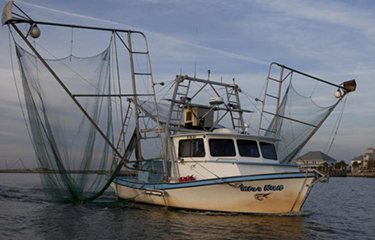Three years after it was proposed, NOAA has adopted a rule to expand sea turtle excluder requirements in the U.S. shrimp fishery – but has decided to spare about 80 percent of shallow water fishermen who could have been affected.
Turtle excluding devices, or TEDs, have been required for years on shrimp otter trawls, and the new rule will impose that on boats 40 feet and over pulling skimmer nets.
TEDS are grates with bars set 4 inches apart to deflect turtles before they get into nets and drown. The rule will narrow that spacing to 3 inches to make the gear more selective for smaller turtles and require lighter webbing on escape flaps to help the young animals get out.
Skimmer boats under 40 feet, pusher-head trawls and wing net or butterfly trawls are excluded from the new requirements.
As originally proposed, the rule “was going to require TEDs on all of the skimmer trawls,” Oceana Fishery Campaign Manager Gib Brogan said. “It would be more effective than the tow times they work under now.”
Efforts to reduce turtle bycatch started with the offshore otter trawl fleet, which has “done a tremendous amount of work” in reducing losses, said Brogan. “The skimmer trawl sector needed some work and that’s why we're disappointed.”
With Gulf of Mexico sea turtle populations recovering now, imposing new restrictions on the small boat fleet would be too burdensome, said Acy Cooper, president of the Louisiana Shrimp Association.
“The turtles are coming back,” with higher numbers and more successful beach nesting reported by the federal government, said Cooper. “They know everything is coming back in the Gulf since the 1980s, and half of the fleet is gone since then.”
“They (NOAA) keep coming at us. It’s unjustified,” Cooper added. “We just had a really bad year with all this fresh water from the Mississippi River flooding the estuaries,” he said.
In its public notice of the final rule, NOAA said the final decision was based on agency deliberations and public comments. Shrimp fishermen said requiring the devices on smaller net boats would not be justified by potential safety issues and costs.
“The changes in the final rule impact 80 percent fewer fishers and reduces the overall economic impact by approximately 73 percent compared to the proposed rule, while retaining many of the environmental benefits,” according to the agency statement.
But the economic outcomes projected by NOAA were not that far apart considering the potential for saving more turtles, and environmental advocates are considering whether to challenge the final rule, said Brogan.
“What was in the proposed rule would have made it very easy to say that U.S.-caught shrimp is safe for turtles,” he said.
In costs and benefits, expanding the excluder rule to smaller vessels would be overreach considering mortality projections, said Cooper.
“Their own studies show it would take eight and a half years for someone like me to catch and kill one,” he said.
Photo courtesy of the Louisiana Department of Fish and Wildlife







